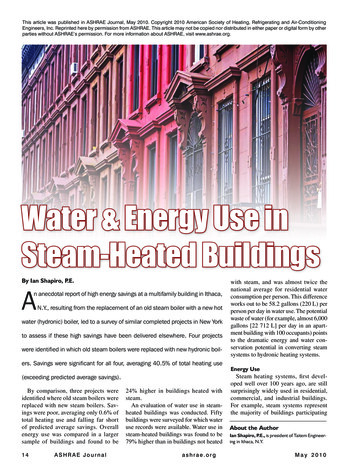
Transcription
This article was published in ASHRAE Journal, May 2010. Copyright 2010 American Society of Heating, Refrigerating and Air-ConditioningEngineers, Inc. Reprinted here by permission from ASHRAE. This article may not be copied nor distributed in either paper or digital form by otherparties without ASHRAE’s permission. For more information about ASHRAE, visit www.ashrae.org.Water & Energy Use inSteam-Heated BuildingsBy Ian Shapiro, P.E.An anecdotal report of high energy savings at a multifamily building in Ithaca,N.Y., resulting from the replacement of an old steam boiler with a new hotwater (hydronic) boiler, led to a survey of similar completed projects in New Yorkto assess if these high savings have been delivered elsewhere. Four projectswere identiied in which old steam boilers were replaced with new hydronic boil-with steam, and was almost twice thenational average for residential waterconsumption per person. This differenceworks out to be 58.2 gallons (220 L) perperson per day in water use. The potentialwaste of water (for example, almost 6,000gallons [22 712 L] per day in an apartment building with 100 occupants) pointsto the dramatic energy and water conservation potential in converting steamsystems to hydronic heating systems.ers. Savings were signiicant for all four, averaging 40.5% of total heating useEnergy Use(exceeding predicted average savings).By comparison, three projects wereidentiied where old steam boilers werereplaced with new steam boilers. Savings were poor, averaging only 0.6% oftotal heating use and falling far shortof predicted average savings. Overallenergy use was compared in a largersample of buildings and found to be14ASHRAE Journal24% higher in buildings heated withsteam.An evaluation of water use in steamheated buildings was conducted. Fiftybuildings were surveyed for which wateruse records were available. Water use insteam-heated buildings was found to be79% higher than in buildings not heatedashrae.orgSteam heating systems, irst developed well over 100 years ago, are stillsurprisingly widely used in residential,commercial, and industrial buildings.For example, steam systems representthe majority of buildings participatingAbout the AuthorIan Shapiro, P.E., is president of Taitem Engineering in Ithaca, N.Y.May 2010
in the Multifamily Performance Program (MPP), a New York are shown in Table 1. Heating system characteristics of the caseState energy-eficiency program for multifamily buildings. A study buildings are shown in Table 2.Sites S2H-3 and S2H-4 had a complete steam-to-hydronicsurvey of 63 buildings in the program found 46 (73%) to beheated with steam boilers, and six other buildings (9.5%) to conversion. At both sites existing two-pipe radiators, as wellbe heated with purchased district steam, for a total of 82.5% as much of the existing piping were retained and reused. Conof the buildings heated with steam. Of these 52 steam-heated densate return piping was replaced in both buildings. For thebuildings, 32 have two-pipe distribution, 10 have one-pipe other ive systems, the distribution systems were repaired asdistribution, and 10 have hydronic distribution systems through needed, but not replaced. S2H-1 and S2H-2 originally had steamthe use of steam-to-water heat exchangers. Most of the build- boilers, hydronic distribution, and a heat exchanger to coupleings are more than 20 years old, but the tradition of steam heat them, which was discarded in the conversion.is so strong that even relatively new buildings, as recent asive years old, have been found to be designed and built with Fuel SavingsPredicted and actual fuel savings are shown in Table 3 withsteam heating systems.These steam heating systems appear to make their buildings the predicted savings taken from energy audits and the actualenergy intensive. In the previous sample of 63 buildings, source savings from pre- and post-retroit fuel bills.Unlike the indings mentioned previously for total sourceenergy use intensity (overall building energy use, includingpower plant fuel, reported in energy audits for each build- energy use, savings are shown here as percent of original heating participating in the program) in steam-heated buildings ing use, not as a percent of total fuel use. Base load use, suchaveraged 159 kBtu/ft2·yr (1 805 687 kJ/[m2·yr]), 24% higher as domestic hot water or gas appliance use, was subtracted outthan the 128 kBtu/ft2·year (1 453 635 kJ/[m2·yr]) average for before savings were calculated. Predicted savings were notbuildings not heated with steam. Although the source energy available for site S2H-3 because this project did not have anuse combines heating use with hot water and electricity, the energy audit. All actual preretroit and post-retroit heating usedifference is certainly large enough to draw attention, especially is weather normalized.because the buildingswere all residential withSteam-to-Steam ConversionsSteam-to-Hydronic Conversionsfive or more units (aBuildingS2S-1S2S-2S2S-3 AverageS2H-1S2H-2S2H-3S2H-4 Averagebuilding type for which651071211337.3Storiesnon-heating energy uses5410804836111612656286.3should be at least some- Apartmentswhat comparable).Number of11111117619.8Prior studies haveBuildingsshown energy tedTypeRateRateRateRateRatefrom converting steamheating systems to hy- Table 1: Building characteristics for seven buildings in New York state.dronic systems. 1, 2 AIn most cases, non-boiler energy conservation measuresmore recent study conirms that buildings with steam heatingdistribution systems have far higher heating fuel intensities (ECMs) were minor, or there were none at all. Where non(18.2 and 14.5 Btu/ft2 HDD [206 689 and 164 670 J/m2 KD] boiler energy conservation measures had been implemented,for one-pipe and two-pipe steam, respectively) than non-steam corrections were made to the savings calculations using datasystems (5.4, 12.5, and 8.3 Btu/ft2 HDD [61 325, 141 957, and from the original energy audit.Site S2H-4 probably represents a worst-case scenario (best94 259 J/m2 KD] for electric, hydronic, and hot air systems,case for fuel savings), as the boiler plant serves multiplerespectively).3buildings, and was known to have an old and leaky distribution system, including underground interbuilding distribuCase Studies of Seven Boiler Replacementstion leaks. Other beneits accrued from the conversion toBuilding CharacteristicsPreretroit and post-retroit utility bills were analyzed for a hydronic system. The improvement reduced operationsseven multifamily residential buildings where old steam boilers and maintenance costs due to the elimination of leaks. Aswere replaced and for which utility bills were available. Six of the new system runs entirely on natural gas, it eliminatedthe seven had participated in a program of the New York State environmental concerns and liabilities related to the use ofEnergy Research and Development Authority (NYSERDA). coal at the central plant.Three buildings had old steam boilers replaced with new steamboilers, and four buildings had old steam boilers replaced Fuel Use AnalysisActual savings from converting to hydronic boilers are farwith new hydronic boilers (and associated distribution systemchanges). The boiler replacements occurred in the period be- higher (40.5% average) than savings from replacement withtween 1996 and 2008. Summary characteristics of the buildings new steam boilers (0.6% average).May 2010ASHRAE Journal15
Actual savings from conSteam-to-Steam ConversionsSteam-to-Hydronic Conversionsversion to hydronic (40.5% average) exceed projected savings (31% average).Fuel, Preretroit#4 oil#2 oil#6 oilGasGasGasGas & CoalActual savings from replacingFuel, Postretroit#2 oil#2 oil#6 oilGasGasGasGasold steam boilers with m boilers (0.6% average)Hydronic HydronicPreretroitSteamSteamSteamSteamSteamare less than projected onic Hydronic HydronicHydronicPostretroitSteamSteamSteamThe sites with the highestsavings (S2H-3 at 49.8% Table 2: Comparison of heating system characteristics for the sample buildings.savings, and S2H-4 at 48.2%savings) are the ones with a complete steam to hydronic conver- data was available from the same NYSERDA multifamilysion. In other words, the preretroit distribution systems were program database. For 23 steam-heated buildings, water usesteam, and the entire systems were converted to hydronic. At averaged 132.1 gallons (500 L) per person per day; whereasS2H-3 and S2H-4, existing two-pipe radiators, as well as much for 27 buildings not heated with steam, water use was found toof the existing piping were retained and reused. Condensate be 73.9 gallons (280 L) per person per day.return piping was replaced in both buildings. The higherThe American Water Works Association (AWWA) found thesavings relative to systems where the preretroit distribution national average U.S. indoor water use to be 69.3 gallons (262system was already hydronic point to distribution leaks or L) per person per day,4 which is very close to the 73.9 gallonsother distribution losses as a signiicant contributor to steam (280 L) per person per day seen in our study for buildings notsystem ineficiencies.heated with steam. At 132.1 gallons (500 L) per person perHowever, one site (S2H-1) had savings that were still substan- day, average water use at the steam-heated buildings is 79%tial (41.2%), although its pre-retroit distribution system was higher than at the buildings we surveyed that are not heatedalready hydronic. And, the other similar system (S2H-2) also with steam, and 91% higher than the national average as rehad signiicant savings (22.6%). So, substantial savings appears ported by AWWA.to be possible even with a preexisting hydronic distributionResults were subjected to a test for statistical signiicance.system where only the boiler is replaced. This inding points Although the data for steam buildings shows more scatter with ato substantial boiler room losses.higher standard deviation (84.7 compared to 16.5 for non-steambuildings) the conidence interval for the difference betweenAre Steam Leaks a Possible Cause of System Ineficiency? the mean water consumption rates (132.1 for steam-heatedWhy do the conversions to hydronic heating from steam sys- buildings, 73.9 for non-steam buildings) conirms a statisticallytems deliver more savings than expected, and the conversions signiicant difference in water consumption between steamto new steam boilers deliver lower savings?heated buildings and non-steam-heated buildings, with 95% Steam systems are hotter than typical hydronic systems, conidence. Only one type of steam heating system, the vacuumwith higher conductive losses.system, appears not to use more water. A small sample of four Steam systems are open to the atmosphere, so there are such buildings averaged 45.1 gallons (171 L) per person perventing losses. Steam system leaks can be less evident day water consumption.because steam can escape directly to the atmosphereThese indings, which implicate steam systems in high waterrather than leaking as water. Conversely, hydronic system use, are supported by data from two of the case study sites forwater leaks are often immediately evident, and are usually which preretroit and post-retroit water use is available. Siterepaired immediately.S2H-4 showed a 26% decrease in water use after replacing a New steam systems are less eficient than new hydronic steam boiler system with a hydronic system. Water cost savsystems. They also have limits to outdoor reset control. ings increase overall cost savings by 17% for the project (whenHydronic systems can be run cooler during swing seasons. added to energy cost savings). By contrast, site S2H-1 withThe indings of the seven boiler conversions (hydronic con- preretroit hydronic distribution only showed a 4% decrease inversions generating savings higher than predicted and steam water use after replacing a steam boiler with a new steam boiler.boiler replacements generating savings lower than predicted) We speculate that steam losses are lower where the preretroitpossibly point to distribution losses as being an important distribution system was hydronic. Steam losses were limitedcomponent.to the boiler room. Therefore, water savings for this systemTo evaluate whether steam systems might have higher steam were lower.or water leak rates than hydronic systems, total water use forsteam-heated buildings was compared to buildings without Conclusionssteam heat (hydronic, electric, or forced air). This was doneSteam-heated buildings were found to use more water thanfor a sample of buildings for which water use and occupancy buildings not heated with steam (almost twice the national16ASHRAE JournalMay 2010
Advertisement formerly in this space.
average, on a per perSteam-to-Steam ConversionsSteam-to-Hydronic Conversionsson basis), serving asBuildingS2S-1S2S-2S2S-3 Average S2H-1S2H-2S2H-3S2H-4 Averagea likely explanation ofwhy converting buildPredicted s from steam heatActual .5%to hydronic heat wasfound to save more Table 3: Savings for steam-to-steam conversions, as compared to steam-to-hydronic conversions.energy than expected,while replacing old steam boilers with new steam boilers was Rosa of Taitem Engineering for collecting and analyzing datafound to save less energy than expected.for the study.AcknowledgmentsReferencesThanks to the NYSERDA Residential Energy AffordabilityProgram’s multifamily group, under the direction of Jim Reisand guidance from Pat Fitzgerald, with contributions fromseveral others on NYSERDA’s staff through identiication ofrelevant projects, providing analysis, and deining an onlinedatabase of projects from which data was drawn. Thanks tostaff from TRC Energy Services, under the direction of MarkLorentzen and Frank Reilly, for contributions to the case studiesand development of the online database. Thanks to Dan Coganof Taitem Engineering for his reviews and comments, as well asoverall support and encouragement. Thanks to Richard Leighof the Urban Green Council (USGBC of NY) for his thoroughreview and comments. Thanks to Susan Galbraith and Javier1. Lobenstein, M.S., and M.J. Hewett. 1986. “Converting steamheated buildings to hot water heat: practices.” Proceedings of theAmerican Council for an Energy Eficient Economy, 1986 SummerStudy (1):183–196.2. Lobenstein, M.S., T.S. Dunsworth. 1989. “Converting TwoPipe Steam Heated Buildings to Hot Water Heat: Measured Savingsand Field Experience.” Minneapolis Energy Ofice, report MEO/TR89-4-MF.3. Guerra, E., R. Leigh. 2006. “Tales From the AMP Database:Energy Consumption in a Selection of New York State MultifamilyBuildings.” Presented at the NYSERDA Multifamily Building Conference, New York City.4. Aquacraft and American Water Works Association ResearchFoundation. 1999. “Residential End Uses of Water.” isement formerly in this space.18ASHRAE JournalAdvertisement formerly in this space.May 2010
identiied where old steam boilers were replaced with new steam boilers. Sav-ings were poor, averaging only 0.6% of total heating use and falling far short of predicted average savings. Overall energy use was compared in a larger sample of buildings and found to be 24% higher in buildings heated with steam. n evalation of water se in steam-











